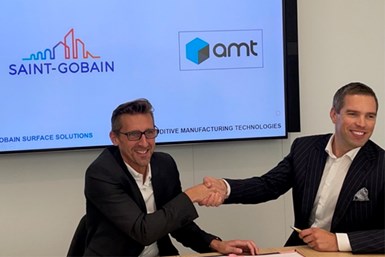Saint-Gobain, AMT Partner to Fuel 3D Printing Postprocessing Growth
The companies will apply the Norton application technologies and systems approach to enable the development of a Technology Upgrade Package (TUP) for AMT’s PostPro chemical vapor smoothing (CVS) process.

Signing the Agreement (L-R) – Laurent Tellier, Saint-Gobain Surface Solutions CEO, and Joseph Crabtree, AMT CEO and founder. Photo Credit: SGSS
Saint-Gobain Surface Solutions (SGSS) has signed a strategic alliance agreement with Additive Manufacturing Technologies (AMT) to leverage each other’s knowledge, expertise and leadership in finishing technologies to drive sales of AMT’s flagship PostPro SF chemical vapor smoothing postprocessing product.
Specifically, SGSS and AMT will together apply the Norton application technologies and Norton systems approach to enable the development of a Technology Upgrade Package (TUP) for AMT’s PostPro chemical vapor smoothing (CVS) process. This TUP will consist of a set of automated software enhancements to enable ease-of-use for operators and efficient utilization of the machines.
“The collaboration between AMT and Saint-Gobain brings together expertise in surface finishing and automation to deliver new generation surface treatment based on AI,” says Dr. Konstantin Rybalcenko, AMT’s head of research and development. “This will provide novel solutions for today’s manufacturing challenges and unlock new windows of opportunities for the Additive Manufacturing sector.”
SGSS is anticipating delivering enhanced solutions to AMT’s customers through this technology and commercial partnership, utilizing the principles from Norton Applications Technology, according to
Dr. Anand Tanikella, vice president of research and development for Saint-Gobain Surface Solutions.
SGSS and AMT will further work together in offering solutions for newer materials and various applications by integrating CVS into the overall finishing system for customers. The parties expect a new TUP will be available on a subscription basis in early 2023.
“The strategic alliance agreement is in line with our ambition to be the preferred provider of surface finishing solutions for 3D printed components,” says Laurent Tellier, Saint-Gobain Surface Solutions CEO.
The feedback from AMT’s customers indicates that the biggest barrier to driving increased adoption and machine usage was the manual recipe creation required for each new set of materials and finishing outcomes. “Through our partnership with SGSS, we are focused on automating the ‘recipes’ that drive the machine,” says Joseph Crabtree, AMT founder and CEO. “This will increase the overall usage of the machines and improve product development cycles, while improving customer satisfaction.”
- Learn how Saint-Gobain 3D Prints tooling for elevated efficiency.
- Read how Additive Manufacturing Technologies (AMT) is taking a green approach for vapor smoothing 3D printed parts with its sustainable PostPro Pure postprocessing.
Related Content
-
3D Printed Cutting Tool for Large Transmission Part: The Cool Parts Show Bonus
A boring tool that was once 30 kg challenged the performance of the machining center using it. The replacement tool is 11.5 kg, and more efficient as well, thanks to generative design.
-
Additive Manufacturing Is Subtractive, Too: How CNC Machining Integrates With AM (Includes Video)
For Keselowski Advanced Manufacturing, succeeding with laser powder bed fusion as a production process means developing a machine shop that is responsive to, and moves at the pacing of, metal 3D printing.
-
Possibilities From Electroplating 3D Printed Plastic Parts
Adding layers of nickel or copper to 3D printed polymer can impart desired properties such as electrical conductivity, EMI shielding, abrasion resistance and improved strength — approaching and even exceeding 3D printed metal, according to RePliForm.















